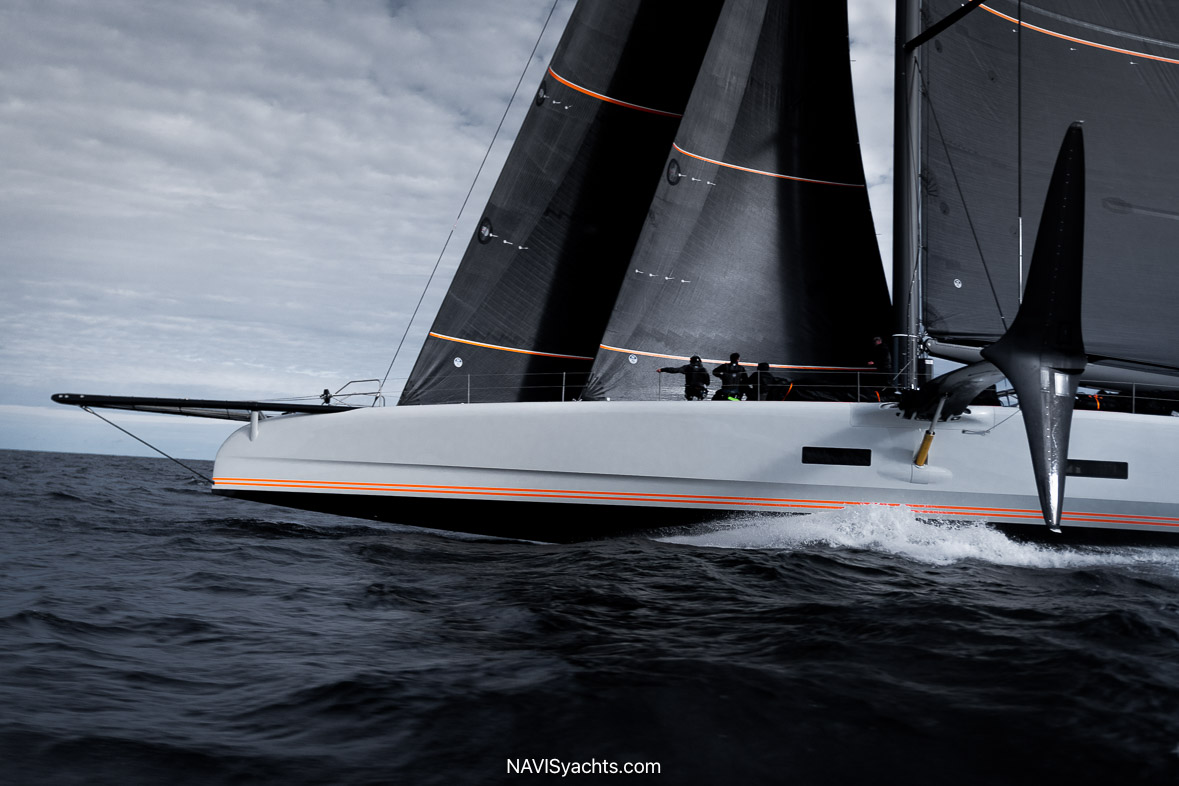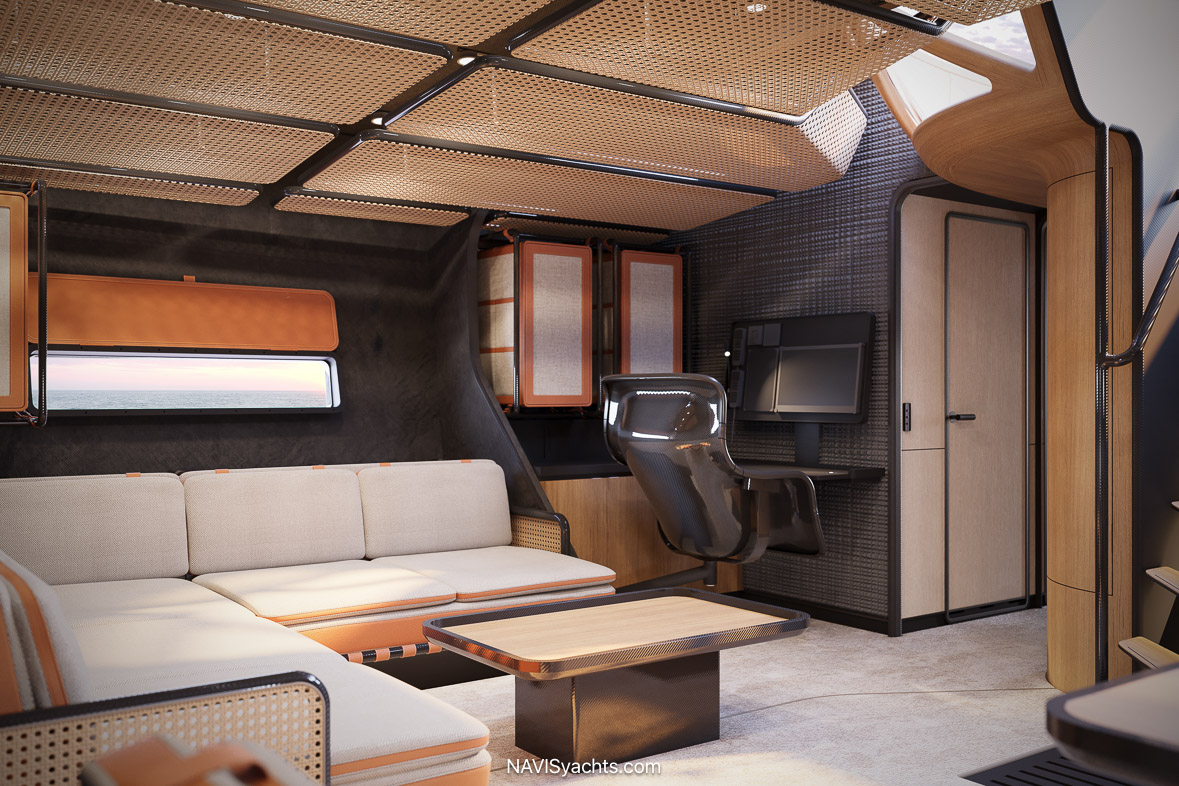Baltic Yachts’ First Foil-Assisted Luxury Sailing Yacht Raven Is A Game Changer
Baltic’s decidedly sui generis 34-meter sailing superyacht is riveting from the very first glance. Meticulously pared down in terms of weight, thoroughly steeped in purposeful industrial chic, and technically superior in materials, systems, and design, Raven is the wild card. A gauntlet thrown down in the luxury sailing yacht game with the potential to change everything.
An assisted foiling yacht, Raven spreads her canting T-wings and lifts her beaked bow from the water only as much as required to reduce the lightship displacement of this phenom to its targeted weight of 55 tons. Peers, if they can even graciously manage to be called that, generally register between 75 and 100 tons. The stern continues playing with the waterline as Raven sails along on her leeward chine, the leeward foil providing a significant proportion of displacement.
From what has been called a “forensic” approach, Baltic Yachts and the elite team of experienced talent set a new bar for sailing yachts quite high. Collect builder Baltic Yachts, the creative force and yacht designer Jarkko Jämsén, naval architects Botin Partners, structural engineers PURE Design and Engineering, project manager Sam Evans, Project coordinator Mattias Svenlin, A2B Marine Projects’ Garth Brewer, and sailing team manager Klabbe Nylöf in one room and the discussion is likely to be the most interesting one of the decade.
Raven is about to weave a remarkable story through itineraries, guests, accomplishments, and technical lessons. Two years in build with extensive sea trials to prove worthy, followed by the fitting of the foils and another round of sea trials, delivery, and crew training, the interesting path taken started quite a bit earlier than one might think.
The Evolution of Foils
In 1861, English engineer Thomas Moy tested a model airplane wing using water instead of air. Towing the model along a canal, the experiment confirmed that his wings generated significant force capable of lifting several tons.
In 1869, Parisian Emmanuel Fargot filed a British patent for a removable system on a rowing boat. His design illustrated hydrofoils, a series of inclined planes and wedges, along the sides and bottom designed to lift the boat and reduce draft. Propulsion for his design, however, proved to be a major hurdle.
Italian Enrico Forlanini, an engineer known for airship and helicopter design, filed a 1906 patent for his ladder foil boat design, applying the principle that lift was proportional to speed squared. His craft weighed about 2,650 pounds, propelled by a 60 hp engine. A successful test in 1906 on Italy’s Lake Maggiore resulted in a recorded speed of 68 kilometers per hour.
Telephone pioneer Alexander Graham Bell took up the race to design a better hydrofoil boat around 1908. With his initial design, Bell achieved a speed of 87 kilometers per hour, Which attracted the interest of the US Navy. Providing two 350 horsepower engines, Bell’s following design set a 114-kilometer-per-hour speed record.
Through dozens of iterations, modern hydrofoils found renewed interest. By the 1980s, Eric Tabarly had begun work on a foiling trimaran that found its way under Alain Thébault’s wing, so to speak. Thébault’s L’Hydroptère averaged 51.36 knots over a 500-meter distance, following up with an LA to Honolulu record.
Evolution from the early days of hydro foiling had become a mainstream goal for designers aiming for speed. From moth dinghies to America’s Cup yachts, advanced and refined designs appear almost daily, setting the stage for extraordinary private yachts like Baltic’s 111 Raven.
Raven By the Numbers
Measuring 34 meters overall and 33.10 meters at the waterline, Raven has a beam of 7.40 meters and a draft of 4.80 meters. It features a hybrid diesel-electric propulsion system with a 130 kW Swiss Phi Power AG electric motor aft of midships and twin 80 kW Yan Mar generators further aft. These charge battery banks that power the main motor, hydraulic pumps, and hotel services, offering lower emissions and efficient weight distribution.
Raven is fitted with a retractable, carbon blade propeller with titanium hub. The 5.3-meter 9.3-ton fixed keel and aft quarters water ballast tanks assist with increasing the righting moment, maintaining stability under sail.
Raven’s canting T-foils on adjustable side arms, targeted to shoulder a lift fraction between 50 and 100%, raise the bow slightly out of water with the stern remaining below the waterline. Fore and aft trim adjustments at speed are fitted with an interceptor and trim tabs on the stern. The yacht is also equipped with twin rudders for increased control and maneuverability.
Conventional Performance Maxi Sailplan
Fitted with a Southern Spars carbon spar, Raven also carries a full main and a triple headed sailplan to make the most of the yacht’s foiling capabilities. Raven’s North 3Di upwind sail wardrobe with Helix structured luff technology includes a variety of Code and asymmetric sails off Raven’s eight-meter bowsprit.
Sailing Raven’s 7.4+ meter beam and pronounced hull chine make it feel more like a multihull, necessitating specific trimming and handling techniques for optimal performance. The mainsail sheet track spans nearly the entire beam. Raven often sails with apparent wind far forward, resembling multihull sailing, where the main is usually sheeted home, adjusted via the mainsheet car. Though designed mainly for daysailing, Raven is also built for high-speed, long-distance voyages.
Photos: Eva-Stina Kjellman, Baltic Yachts Media Words: K.L. Turner
Credit: Source link

